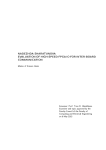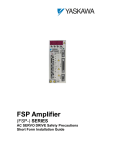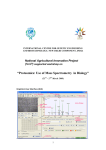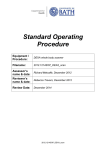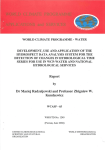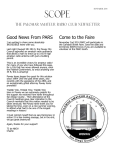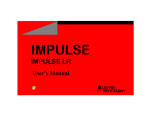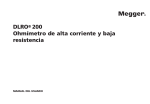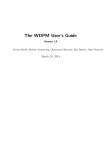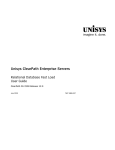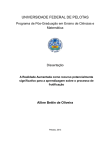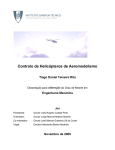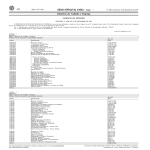Download Full Text
Transcript
Moving to a Smart Distribution Grid through Automatic Dynamic Loading of Substation Distribution Transformers by Yi Liu A Thesis Presented in Partial Fulfillment of the Requirements for the Degree Master of Science Approved July 2011 by the Graduate Supervisory Committee: Daniel J. Tylavsky, Chair George G. Karady Raja Ayyanar ARIZONA STATE UNIVERSITY August 2011 ABSTRACT Dynamic loading is the term used for one way of optimally loading a transformer. Dynamic loading means the utility takes into account the thermal time constant of the transformer along with the cooling mode transitions, loading profile and ambient temperature when determining the time-varying loading capability of a transformer. Knowing the maximum dynamic loading rating can increase utilization of the transformer while not reducing life-expectancy, delaying the replacement of the transformer. This document presents the progress on the transformer dynamic loading project sponsored by Salt River Project (SRP). A software application which performs dynamic loading for substation distribution transformers with appropriate transformer thermal models is developed in this project. Two kinds of thermal hottest-spot temperature (HST) and top-oil temperature (TOT) models that will be used in the application—the ASU HST/TOT models and the ANSI models—are presented. Brief validations of the ASU models are presented, showing that the ASU models are accurate in simulating the thermal processes of the transformers. For this production grade application, both the ANSI and the ASU models are built and tested to select the most appropriate models to be used in the dynamic loading calculations. An existing application to build and select the TOT model was used as a starting point for the enhancements developed in this work. These enhancements include: Adding the ability to develop HST models to the existing application, Adding metrics to evaluate the models accuracy and selecting which model will be used in dynamic loading calculation Adding the capability to perform dynamic loading calculations, iii Production of a maximum dynamic load profile that the transformer can tolerate without acceleration of the insulation aging, Provide suitable output (plots and text) for the results of the dynamic loading calculation. Other challenges discussed include: modification to the input data format, data-quality control, cooling mode estimation. Efforts to overcome these challenges are discussed in this work. iv DEDICATION This thesis is dedicated to my parents who have supported me all the way since the beginning of my studies. Also, this thesis is dedicated to my wife who has been a great source of motivation and inspiration. v ACKNOWLEDGEMENTS I would like to thank Salt River Project for providing me an opportunity to perform this research work. I appreciate the contributions of Gary A. McCulla, Wesley B. Knuth, Kenneth E. Brown, Thomas W. LaRose, and Dustin J. Stapp at Salt River Project, towards this research. I am deeply indebted to my advisor Dr. Daniel J. Tylavsky for advising me and for the direction he has lent to this project. His expertise and insight have been influential in performing this research work. His teaching and work ethic are an inspiration. I would also like to thank the members of my supervisory committee, Dr. Karady and Dr. Ayyanar for their support. I am also obliged to the faculty of the power engineering group at Arizona State University for their guidance. In addition, I thank all my friends in the area of electric power and energy systems for their support when I needed it the most. vi TABLE OF CONTENTS Page LIST OF TABLES ........................................................................................................ xi LIST OF FIGURES .....................................................................................................xii NOMENCLATURE ...................................................................................................xiii CHAPTER 1 INTRODUCTION ................................................................................... 1 1.1 Overview ......................................................................................................... 1 1.2 Objective of the Research ............................................................................... 4 1.3 Literature Review of Thermal Models ............................................................ 4 1.3.1 TOT Models ..................................................................................... 5 1.3.2 HST Models ...................................................................................... 6 1.4 Thesis Outline ................................................................................................. 7 CHAPTER 2 REVIEW OF EXISTING TOT MODEL APPLICATION ..................... 9 2.1 Introduction ..................................................................................................... 9 2.2 ANSI TOT Model ......................................................................................... 10 2.3 ASU TOT Model .......................................................................................... 11 2.3.1 Introduction to ASU TOT Model ................................................... 11 2.3.2 Linear Regression and Least Square Method ................................. 11 2.4 Input Data and Data Filtering........................................................................ 13 2.5 Maximum Steady-State Load (SSL) and Bootstrapping............................... 16 2.6 Conclusions ................................................................................................... 18 CHAPTER 3 INTRODUCTION TO HST MODELS AND APPLICATION ............ 19 3.1 Introduction ................................................................................................... 19 3.2 ANSI HST Model ......................................................................................... 19 vii Page 3.3 ASU HST Model ........................................................................................... 21 3.4 Input Data Format and Data Quality Control................................................ 22 3.4.1 Data Source and Format ................................................................. 23 3.4.2 Data Quality Control ...................................................................... 23 3.4.3 Cooling Modes Determination ....................................................... 25 3.5 Steady-state-load Prediction and Bootstrapping ........................................... 26 3.5.1 Maximum SSL predicted by ANSI HST Model ............................ 27 3.5.2 Maximum SSL Predicted by ASU HST Model.............................. 28 3.6 Process Integration ........................................................................................ 30 3.7 Conclusions ................................................................................................... 33 CHAPTER 4 THE PROGRAM GUI DESIGN AND MODEL SELECTION ........... 34 4.1 Introduction ................................................................................................... 34 4.2 GUI Design ................................................................................................... 34 4.2.1 Operational Area............................................................................. 35 4.2.2 Transformer Data(EMS) Area ........................................................ 36 4.2.3 ANSI Parameter Area ..................................................................... 37 4.2.4 Output Area .................................................................................... 38 4.2.5 Dynamic Loading Calculation ........................................................ 40 4.3 Modification to the ANSI Parameters Input ................................................. 41 4.4 Model Selection ............................................................................................ 43 4.5 Conclusion .................................................................................................... 45 CHAPTER 5 DYNAMIC LOADING CALCULATION ........................................... 47 5.1 Introduction ................................................................................................... 47 viii Page 5.2 Concept of Dynamic Loading Calculation.................................................... 47 5.3 Fix the bad data in 24-hour cycle .................................................................. 49 5.4 Dynamic Loading Calculation for 24-hour Cycles ....................................... 51 5.4.1 Load Estimation .............................................................................. 53 5.4.2 HST/TOT Calculation .................................................................... 54 5.5 Examples of Dynamic Loading Calculation ................................................. 55 5.5.1 Example of Tryon2 Transformer .................................................... 55 5.5.2 Example of Welborn3 Transformer ................................................ 57 5.6 Conclusions ................................................................................................... 58 CHAPTER 6 CODE OPTIMIZATION AND EFFICIENCY IMPROVEMENT....... 59 6.1 Introduction ................................................................................................... 59 6.2 Efficiency Improvement ............................................................................... 59 6.2.1 Reduction of Dataset Size............................................................... 60 6.2.2 Using Vector Operations Instead of Loops .................................... 60 6.2.3 Putting Loops in MEX C Files ....................................................... 60 6.3 Conclusions ................................................................................................... 61 CHAPTER 7 CONCLUSIONS AND FUTURE WORK ............................................ 62 7.1 Conclusions ................................................................................................... 62 7.2 Future Work .................................................................................................. 64 REFERENCES ............................................................................................................ 66 APPENDIX A USER’S MANUAL FOR THE APPLICATION DEVELOPED ....... 68 1. System Requirement ............................................................................................. 69 2. Installation ............................................................................................................ 69 ix Page 3. How to use the program........................................................................................ 69 3.1 Read in data file ............................................................................................ 70 Open a CSV File ............................................................................. 70 Open A MAT File........................................................................... 71 3.2 Input the MVA Base ..................................................................................... 73 3.3 Select an ANSI Parameter Record ................................................................ 73 3.4 Specify Whether to Create an Analytical Representation for the Steady State Load Confidence Interval vs. Sample Size ................................................... 74 3.5 Click on “Create Model” Button to Create the Model .................................. 74 3.6 Click on “Dynamic loading calculation” Button to create dynamic loading profile ............................................................................................................ 74 APPENDIX B INPUT DATA FORMAT OF THE APPLICATION ......................... 76 x LIST OF TABLES Page Table 1.1 Aging Acceleration Factor at Different HST Values..................................... 3 Table 2.1 Transformer Data Components .................................................................... 14 Table 3.1 Value of the Exponent m For Different Cooling mode ............................... 20 Table 3.2 Transformer Data Components .................................................................... 23 Table 4.1 SSL values from Burton transformer ........................................................... 44 Table 4.2 SSL values from Pendergast transformer .................................................... 44 Table 5.1 Effects of missing different lengths of Load ............................................... 51 Table 5.2 Effects of missing different lengths of Ambient Temperature .................... 51 Table 6.1 Execution Time Comparison ....................................................................... 61 xi LIST OF FIGURES Page Fig. 1.1 A plot of AAF vs. HST relative to 110ºC......................................................... 2 Fig. 2.1 The GUI interface of existing program ............................................................ 9 Fig. 2.2 Conservative Rating ....................................................................................... 17 Fig. 3.1 Distribution Curve of SSL limited by HST .................................................... 30 Fig. 3.2 The flowchart of the new program ................................................................. 31 Fig. 4.1 The new GUI interface ................................................................................... 35 Fig. 4.2 Six steps to build a model and perform dynamic loading .............................. 36 Fig. 4.3 the transformer data (EMS) area .................................................................... 36 Fig. 4.4 Popup list of ANSI models ............................................................................. 37 Fig. 4.5 ANSI Model Data ........................................................................................... 37 Fig. 4.6 Output area ..................................................................................................... 38 Fig. 4.7 Probability density function curve .................................................................. 39 Fig. 4.8 Error Duration Curve ...................................................................................... 40 Fig. 4.9 Dynamic Loading Calculation ........................................................................ 41 Fig. 4.10 Flowchart of models selection ...................................................................... 45 Fig. 5.1 The flowchart of whole dynamic loading procedure ...................................... 48 Fig. 5.2 An example of bad data .................................................................................. 49 Fig. 5.3 The flowchart showing dynamic loading calculations ................................... 52 Fig. 5.4 Measured Data on 2009-7-1 for Tryon2 Transformer .................................... 56 Fig. 5.5 Predicted Data on 2009-7-1 for Tryon2 Transformer .................................... 56 Fig. 5.6 Measured Data on 2010-7-15 for Welborn3 Transformer.............................. 57 Fig. 5.7 Predicted Data on 2010-7-15 for Welbron3 Transformer .............................. 58 xii NOMENCLATURE AAF Insulation Aging Acceleration Factor ANSI American National Standards Institute C Thermal capacity FA Oil-natural-air-forced cooling mode FOA Oil-forced-air-forced cooling mode FSR Full scale rise of the HST over TOT of the transformer at rated load HST Hottest-spot temperature I The transformer load IEEE Institute of Electrical and Electronics Engineer I pu Ratio of the load under consideration to the rated load Irated Rated load J Regressors or parameters index K Time step index K1 to K4 Coefficients of ASU TOT model L1m ,L2 ASU HST models parameters LL Load loss of transformer Loadpu[k] The per unit load at the kth observation, m An empirically derived exponent, selected for each cooling mode, to approximately account for changes in resistance and viscosity with changes in load xiii n Top oil cooling exponent NL No-load loss of transformer nt Observation index OA Oil-natural-air-natural cooling mode OFAF Oil-forced-air-forced cooling mode ONAF Oil-natural-air-forced cooling mode ONAN Oil-natural-air-natural cooling mode p Number of parameters POT Power transformer QC Quality Control Index R Ratio of load loss to no-load loss at rated load. r Number of regressor variables S Load under consideration (MVA) SDT Substation distribution transformer SHST Simulated hottest-spot temperature SRP Salt River Project SSL Steady-state load SSLMax Maximum predicted load; t Time duration of load (minutes) Th Winding time constant at hottest-spot location (minutes) Tamb,N Nominal ambient temperature TOT Top-oil temperature(C) xiv TOTmax Maximum acceptable TOT(C) x Predictor or regressor variable X A nt by p matrix containing the r regressor variables xj The jth regressor variable xij The ith observation or level of regressor xj Y Response variable in a regression model yi Measured value of the responsible variable at the ith observation ŷi Fitted value of the responsible variable at the ith observation Y Is a n by 1 vector of the y variables. B Regression coefficient or model parameter βj The jth model parameter Β A p by 1 vector of the β parameters Δt Sampling period E nt 1 vector of random errors oil : Thermal oil time constant at rated load (hours). θamb The ambient temperature (C) fl Top–oil rise over ambient temperature at rated load ( C ). θh Hottest-spot temperature rise over top-oil temperature (C) θhu Ultimate hottest-spot temperature rise over top-oil temperature for load I (C) θhi Initial hottest-spot temperature rise over top-oil temperature (C) θhr Hottest-spot temperature rise over top-oil temperature at rated load xv (C) θhst Hottest-spot temperature (HST) (C) i Initial top–oil rise for load in ( C ). o TOT rise over ambient temperature ( C ). θtop Top-oil temperature (TOT) (C) θtr TOT rise over ambient temperature at rated load (C) u : Ultimate TOT temperature rise ( C ). xvi CHAPTER 1 INTRODUCTION 1.1 Overview Substation distribution transformers (SDTs) and power transformers (POTs) are widely used in the electric power industry. In order to improve the transformer utilization and obtain maximum benefit, utilities are trying to load those transformers as heavily as possible so that millions of dollars can be saved by installing fewer transformers and/or delaying the installation. However, the load on a transformer cannot be increased indefinitely without causing premature aging of transformer’s insulation. Aging or deterioration of insulation is a time-function of temperature, moisture content, and oxygen content. The moisture and oxygen contributions to insulation deterioration can be minimized with modern oil preservation systems, leaving insulation temperature as the primary parameter [1]. The primary contributor to insulation temperature is the heat generated by load losses. Since the deterioration to the insulation is related to the insulation temperature and the temperature distribution due to load losses is not uniform in the windings in most cases, it’s reasonable to believe that the greatest deterioration to the insulation will happen at the part of the winding operating under the highest temperature condition. Therefore, in aging studies it is usual to consider the aging effects caused by the hottest-spot temperature (HST). Deterioration of insulation is accelerated beyond normal for temperature over a “normal” reference temperature of 110ºC, and reduced when temperature is below 110οC. This “normal” reference temperature is given by the IEEE transformer loading 1 guide, Std C57.91-1995 [1]. According to that guide, the transformer per-unit insulation life has the following form: Per unit life 9.8 10 15000 18 HST 273 (1.1) e Equation (1.1) yields a value of 1 per unit life for the reference HST of 110 ºC and it is the basis for calculating the aging accelerating factor (AAF). The AAF is the rate at which a transformer insulation aging is accelerated compared with the aging rate at 110 ºC. AAF is given as AAF e 15000 15000 383 HST 273 (1.2) AAF is greater than 1 when the HST is over 110 ºC and less than 1 when the HST is below 110 ºC. A curve of AAF vs. HST is shown in Fig. 1.1 and some AAF values at different temperatures are presented in Table 1.1. 1800 1600 Aging Acceleration Factor 1400 1200 1000 800 600 400 200 0 50 X: 110 Y: 1 100 150 Hottest-Spot Temperature (deg C) Fig. 1.1 A plot of AAF vs. HST relative to 110ºC 2 200 The conclusion from Fig. 1.1 and Table 1.1 is that the loss of life of transformer insulation is related to the HST exponentially. Because the value of HST is a function of transformer loading, normally utilities set a utility-specific HST value (110 ºC is a typical one) as the highest HST in operation to limit the loss of insulation life. Table 1.1 Aging Acceleration Factor at Different HST Values HST(ºC) 70 80 90 100 AAF 0.0104 0.0358 0.1156 0.3499 HST(ºC) 110 120 130 140 AAF 1 2.7089 6.9842 17.1995 HST(ºC) 150 160 170 180 AAF 40.589 92.0617 201.2294 424.923 To measure and monitor the exact value of the HST, fiber optics probes can be applied without interrupting the normal operation of the transformer; however, the measurement of HST has been very difficult until recently. So the top-oil temperature (TOT), the temperature of the transformer cooling oil at the top of the oil reservoir, has been used for a long time as the limiting factor where there is no HST measurement instrument. Indeed, most utilities set limits on operational TOT as well as HST; therefore TOT and HST should be predicted accurately so that dynamic loading can be performed to improve transformer utilization. Dynamic loading is the term used for one way of optimally loading a transformer. Dynamic loading means the utility takes into account the thermal time constant of the transformer along with the cooling mode transitions, loading profile and ambient temperature when determining the time-varying loading capability of a transformer. So the transformer would be loaded heavily enough while the HST remains below its prescribed limitation. Loading ratings when dynamic loading is performed can exceed 3 the transformer’s nameplate rating for a certain period according to the aforementioned variable. And knowing the maximum dynamic loading rating can increase utilization of the transformer while not reducing life-expectancy, delaying the replacement of the transformer. It is necessary to be able to predict the TOT/HST value of a transformer for load-planning and scheduling purposes. And the TOT/HST is the preferred temperature for constraining dynamic loading. In order to find out the exact relationship between TOT/HST and load to perform dynamic loading, utilities must have accurate thermal models of the transformer. 1.2 Objective of the Research Salt River Project (SRP) has been interested in a software application that could be used to perform dynamic loading of substation distribution transformers. At its core, the application must be capable of reading in measured data and producing transformer thermal models. In addition, the application must use these models to perform dynamic loading calculations. There are challenges to integrating both TOT and HST thermal model building algorithms into one application and developing an algorithm for performing dynamic loading calculations in a production grade environment. The objective of this work is to develop a production grade application for the planning engineers at SRP to perform dynamic loading. To select which model should be used in that production grade tool, a literature review of the models is needed. 1.3 Literature Review of Thermal Models The top-oil temperature (TOT) and hottest-spot temperature (HST) need to be predicted accurately in order to improve transformer utilization without accelerating the aging of insulation, especially when the transformer is working near the TOT or 4 HST utility-prescribed limits. Many thermal models have been developed in literature for predicting TOT and HST. Historically, utilities have used the ANSI models, given in clause 7 of the IEEE loading guide [1], along with parameters distilled from the transformer heat-run test report to predict TOT and HST values. But this model has been subjected to criticisms about its adequacy and accuracy in [2]—[7]: The effects on TOT and HST prediction by ambient temperature variation are not taken into account accurately and experience shows that this model, used with the transformer test report parameter, is much less accurate than desired. Because the ANSI clause 7 model has such drawbacks, other models and model-acceptability tests have been proposed in the literature [2]—[14]; however, none of these models have yet found universal acceptance. The ANSI models, despite it documented flaws, remains the industry standard. As state earlier, when there is no HST measurement instrument, TOT and/or simulated HST (which is based on TOT and load) is use for constraining dynamic loading. Therefore, both TOT and HST models have been examined in the literature. 1.3.1 TOT Models There are several kinds of TOT models other than ANSI model available in literature. A linearized model that considered dynamics of ambient temperature was developed and is referred to as the top-oil model, which shows significant improvement compared with ANSI Clause 7 model [2]. More recently, several papers contained fundamental developments in TOT prediction, introducing different fundamental models for simulating transformer temperatures. The basic analogy between thermal and electrical processes is utilized 5 to propose models for the transformer temperature problem. Swift, Molinski and Lehn developed a thermal model for TOT based on that analogy in [3]. The I2R losses were represented as ideal current sources and the ambient temperature is represented as an ideal voltage source. The thermal resistance and capacitance were represented by electrical resistance and capacitance respectively. The equivalent electrical circuit obtained was used in the development of the thermal model. The validation of the Swift model developed in [3] was given in [4], showing that this TOT model adequately predicts the top-oil temperature. A nonlinear transformer thermal model based on the same thermal-electrical analogy in [3] is developed in [5], focusing on the nonlinear thermal resistance of the transformer oil. That nonlinear model also takes into account the variation in oil viscosity and winding resistance by temperature. The optimized result showed that the curves of the measured and calculated top-oil temperatures are very close. Papers [6] and [7] compared the prediction performance of the TOT equations developed in [2] (both nonlinear and linear versions), [3] and [5] to each other. Adequacy, accuracy and consistency of the models were used as the metrics to measure the acceptability of the models. The linearized TOT model of [2] was found to have the best prediction performance among those models. According to this result, the modified version of the IEEE Clause 7 model given in [1] was chosen in developing the application. 1.3.2 HST Models Similar to TOT models, there are many HST models proposed in the literature, each of them making different simplifying assumptions. A linearized HST equation can be derived by analogy to the linearized TOT model in [2]. Also, another HST 6 equation can be derived by analogy from the TOT equation presented in [3], although the equation is not provided in the paper. Reference [5] contains an HST model developed with the nonlinear thermal resistance of the transformer oil, taking into account the effect on oil viscosity and winding resistance by temperature. The Clause 7 model equations assume that the oil temperature in the cooling ducts is the same as the temperature of tank top oil during overloads. However, paper [8] showed that during overloads, the oil temperature in the winding cooling ducts is higher than the top-oil temperature in the tank. This difference in temperature results in greater actual winding hottest-spot temperature than predicted by the Clause 7 model. Pierce developed very detailed and comprehensive equations for thermal models in [9]. However the model requires the use of bottom-oil temperature and other transformer parameters that are not usually available in manufacturers’ heat-run test report. The following references [10]—[14] contain HST models that require information and parameters that are not easily obtained. These parameters are not available to the utilities from the transformer heat-run test report. The linearized HST model of [2] was found to have a good prediction performance among the models. Thus, this model is selected in the application as the HST model. 1.4 Thesis Outline The rest chapters of the thesis are organized as follows. As there is an existing application developed for a previous sponsor to build the TOT model, CHAPTER 2 will be a review of that existing application. How to do the data quality control and bootstrapping technology will be discussed, which works as the starting point of the 7 production grade tool. CHAPTER 3 will give a detailed analysis of the HST models and how they are integrated into the existing application. CHAPTER 4 provides a discussion of the program GUI, and solves the challenge of reading in ANSI parameters from PTLoad files. A discussion on model selection and examples will also be given. Calculating the dynamic loading level will be the content of CHAPTER 5. In CHAPTER 6, how to accelerate the execution of the program is discussed. CHAPTER 7 shows the conclusions and future work. The appendix defines the data format for the input data. 8 CHAPTER 2 REVIEW OF EXISTING TOT MODEL APPLICATION 2.1 Introduction The objective of this work is to develop a production grade application so that the SRP planning engineer can perform dynamic loading. A partial application, Transformer Thermal Modeling Program (TTeMP), was developed in 2003 [15] but it was incomplete for several reasons: most notable was the absence of an HST model. Also this application was limited to selecting the TOT model and was not capable of performing the dynamic loading calculation. The existing application mentioned above builds the ASU TOT model and compares the results with ANSI Clause 7 model. This application is composed of data filtering, bootstrapping, model building and model selection. A detailed review of the existing program will be provided in this chapter. This existing program will serve as a template for describing the enhancement of the application to include the HST model. Fig. 2.1 is the GUI interface of the existing TTeMP program. Fig. 2.1 The GUI interface of existing program 9 2.2 ANSI TOT Model The IEEE Standard C57.91-1995 presents the ANSI TOT model, which is a function of the load and the load-loss-to-no-load-loss ratio [1]. The top-oil-rise-over-ambient temperature model presented in [1] is commonly used by electric utility industry in order to predict the TOT of the substation distribution transformers. The top-oil-rise model is governed by a differential equation oil d o o u dt (2.1) The solution is an exponential function o u i 1 e t / oil I pu * R 1 u fl R 1 oil I pu i (2.2) n (2.3) C fl (2.4) Pfl I (2.5) I rated The variable fl is obtained from heat-run tests and corresponds to the TOT rise over ambient at rated load. Equation (2.2) describes the transformer thermal behavior as a model of first order [1]. Then, the TOT is given by oil o amb ( u i )(1 e (t / ) ) i amb oil (2.6) For the purposes of parameter estimation and subsequently HST and TOT prediction, the equation shown in (2.1) is discretized by using the equation of backward Euler approximation for the time derivative: 10 d o [k ] o [k ] o [k 1] dt t (2.7) The discretized form of equation can be written as o [k ] 2.3 t fl I [k ] o [k 1] t oil t I rated oil oil 2n (2.8) ASU TOT Model 2.3.1 Introduction to ASU TOT Model The present TTeMP application builds two TOT models for predicting TOT: the ANSI model and the ASU model. The ANSI model implemented in the program is the so-called top-oil-rise model presented in the ANSI/IEEE C57.91-1995 standard [1]. However, as this ANSI model is criticized for its accuracy and adequacy, the application also builds the ASU TOT model and selects the model with better performance. The ASU TOT model approximates the thermodynamic process as top [k ] K1 I pu [k ]2 K 2 amb [k ] K 3 top [k 1] K 4 (2.9) Compared to ANSI Clause 7 model, ASU TOT model takes the dynamics associated with the ambient temperature into account [2][15]. Recognizing that (2.9) is a linear equation, optimal K1 to K4 can be (and are) calculated from measure data using linear regression. For that purposes, linear regression strategies are presented in the next section. 2.3.2 Linear Regression and Least Square Method A multiple regression model that describes the relationship between the output response y and the k regressors or predictor variables can be represented as follows: y 0 1 x1 2 x2 k xk 11 (2.10) The parameters j , j 0,1,k are called the regression coefficients. Suppose that nt k observations are available, and let yi denote the ith observed response and xij denote the ith observation of the regressor x j . The least squares method can be used to estimate the regression coefficients of equation (2.10). Two key assumptions are made that the error term in (2.10) is normally distributed with mean zero and variance 2 , and the errors are uncorrelated. Expressing the equation (2.10) in matrix form gives: y Xβ ε (2.11) where y is an nt 1vector of the observations, X is an nt p matrix of regressors, β is a p 1 vector of the unknown regression coefficients and ε is an n 1 vector of random errors . Thus, the least squares estimator β̂ can be found by minimizing the cost function n S (β) i2 ε T ε (y Xβ) T (y Xβ) y Xβ i 1 2 (2.12) 2 Expanding equation (2.12) results in S (β) y T y - β T X T y - y T Xβ β T X T Xβ (2.13) The terms β T XT y and y T Xβ are scalars. Thus equation (2.13) can be rewritten as S (β) y T y - 2β T X T y β T X T Xβ Therefore the least-squares estimator must satisfy 12 (2.14) S (β) ˆ 0 2X T y 2X T Xβ β (2.15) Arranging terms, Equation (2.15) simplifies to X T Xβˆ X T y (2.16) Equation (2.16) is usually called the least-squares normal equation. If Rank (X) is n, the columns of X are linearly independent and the least-square estimator of β , is given by βˆ (X T X) -1 X T y (2.17) The top-oil model described in (2.9) can be rearranged as follows oil (k ) oil [k 1] K1 I pu [k ] K 2 amb [k ] oil [k 1] K 3 (2.18) Equation (2.9) shows that K1 is the TOT increment due to a load of 1 per unit, K2 is the coefficient of the term that accounts for any heat gain/loss between TOT and ambient temperature, and K3 is the TOT increment due to no-load losses. Letting y denote oil (k ) oil [k 1] , i denote K1 K 2 K 3 , and xi denote I pu [k ] , and amb[k ] oil[k 1] , one can transform equation (2.18) into equation (2.9); thus coefficients K1 to K4 can be estimated from measured load, ambient temperature and TOT using the linear-regression technique and least-square method. 2.4 Input Data and Data Filtering Before performing linear regression, TTeMP program must acquire the measured data and remove erroneous data from the input data stream. The input TOT-related data is sampled every 15 minutes and available in a *.csv files provided by the utility. The components of the data are presented in 13 Table 2.1. A data observation consists of the sampled ambient temperature, sampled TOT, and the time when the samples were taken. The data file may contain multiple “QC” columns as the data quality check for the data in the immediately preceding column. Table 2.1 Transformer Data Components Sampling Time Load Ambient Temperature Top oil Temperature Units HH:MM:SS MVA ο F ο C QC Indexed? No Yes Yes Yes Data filtering (also known as data-quality control) is used to identify those bad data that degrade the reliability of the model, and then remove the bad data from input data set. Categories of bad data and how those bad data are handled are listed below: 1) Measurements marked as erroneous in the input data set by the utility The present TTeMP application allows the utility to do some pre-processing of the measured data and allow for QC identifiers in the data set. It is found that the model will not be significantly affected by using linear interpolation to fill in missing data values if there are less than 2.5 consecutive hours of erroneous/missing measurements [15]. For more than 2.5 hours of consecutive bad data, the measured data is presently discarded by TTeMP, leaving gaps in the dataset. 2) Ambient temperature out of range As the lowest recorded temperature in Phoenix, AZ is 17ºF and the highest is 122ºF, the data with ambient temperature between 15ºF and 125ºF is considered as useful data. And the data outside the range is discarded. 14 3) Spikes in TOT Situations where TOT may change by 4ºC or more in 15 minutes have been observed in the input data; however, such a change is physically impossible. These spikes may be corrected by linearly interpolating between the adjacent TOT data points. 4) Rapid and large jumps in ambient temperature Large prediction errors would occur if the model is used for TOT prediction when there is a rapid change in the ambient temperature input data due to rain. A wet transformer experiences evaporative cooling, which is a different thermodynamic condition and requires a separate model. The solution is to eliminate the 12 hours of data after each quick ambient temperature change (indicative of rain), which would allow the transformer to be completely dry before the data can be used again. 5) Large discrete load changes It was observed that the models built did not perform well when large load changes occur. Solution to this problem is to drop the data that are affected by those abrupt load changes. 6) Data with incorrect cooling mode information. Each mode of cooling represents a different thermodynamic cooling condition and must be represented by a different thermal model. If the cooling mode information is incorrect in the input data set, data from one cooling mode will erroneously be used to train the model for another cooling mode, giving erroneous model coefficients. To solve this problem, the users are asked to define the fan turn on/off temperatures and simulated HST is used to assign the measured data to the correct cooling modes. 15 After data-quality control and cooling mode separation (which is combined in the data-quality-control portion of the application), a *.mat file is created containing the cleaned data set. It contains the same data as its corresponding *.csv file but the data has gone through the data quality control process. 2.5 Maximum Steady-State Load (SSL) and Bootstrapping In the existing application, maximum steady-state load (SSL) is the criteria to determine which model, ANSI TOT or ASU TOT, should be used. The transformer coefficients K1 , K 2 , K 3 , K 4 are estimated from measured data by using the least squares technique and then the maximum SSL’s predicted by each model are calculated. Under steady-state conditions, it is assumed that ambient temperature and load are constant; therefore the steady-state TOT is constant. In this regard, setting top [k 1] top [k ] in equation (2.18) and solving for the load, I , gives the maximum steady-state load as follows: SSLMax K 2 TOTmax Tamb,N K 3 (2.19) K1 Usually it is desired to load the transformer conservatively. For this purpose, “Conservative Rating” is introduced. A 95% conservative rating means there is a 95% chance that the true maximum steady-state load that the transformer can tolerate is greater than this conservative rating. On a probability density function graph; this means the area under the probability function curve and to the right of conservative rating point is 95%, as illustrated in Fig. 2.2. As references, the 99.9% and 50% conservative rating points are also shown in Fig. 2.2. The 50% conservative rating is equal to the mean rating. 16 Fig. 2.2 Conservative Rating A statistical technology named bootstrapping is applied to find Conservative Rating values. Bootstrapping is the practice of estimating properties of an estimator (such as its variance) by measuring those properties from the sampled approximating distribution. When a set of observations can be assumed to be from an independent and identically distributed population, bootstrapping can be implemented by constructing a lot of samples of the observed dataset and then applying the sampled datasets in steady-state load calculation. In this application, the program estimates the variance of steady-state load. To perform bootstrapping, the following steps were implemented for a 30-day data set: 1. Divide the data into 30 individual 1-day data set 2. Generate 30 days bootstrap samples. In the program, 3,000 groups of bootstrap samples are produced. 3. Calculate the coefficient of variation (CV) of ˆ for each of these groups of bootstrap samples. 4. Build the distribution model of steady-state load with CV and mean value of the maximum SSL from those groups of bootstrapping samples. 17 5. Calculate the 95% conservative maximum SSL from the distribution model. The 95% conservative maximum steady-state load is used as the criteria of model selection. If both ASNI and ASU model’s 95% conservative steady-state load prediction are greater than 1.3 per unit, then none model is available. Else the program would use the predicted value and choose the model with greater value of prediction. 2.6 Conclusions The existing program shows how to do data filtering, bootstrapping, model building and model selection, making it a template for describing the future enhancement of the application to include HST models. Its drawbacks are missing of dynamic loading calculation and HST model. These problems would be solved in next chapter. 18 CHAPTER 3 INTRODUCTION TO HST MODELS AND APPLICATION 3.1 Introduction In this chapter, two kinds of HST models - the ANSI clause 7 HST model and ASU HST model - will be discussed. The prediction accuracy of the both models will also be given to determine the better model. The flow-chart-level description of the enhancement needed in building these two models from measured data will be shown, including how the extra functions can be integrated into the existing program discussed in chapter 2. This will allow that the resultant industrial-grade application to select models for TOT and HST instead of just the TOT model. 3.2 ANSI HST Model Traditionally, the ANSI Clause 7 model given by IEEE loading guide Standard C57.91-1995[1] is used to predict HST rise over TOT. This first order model to predict HST rise over TOT is described with the following differential equation: Th d h h hu dt (3.1) The solution to this differential equation is: h hu hi 1 e t / T hi (3.2) hu hr I pu 2 m (3.3) h The suggested values of m are given in Table 3.1. 19 Table 3.1 Value of the Exponent m For Different Cooling mode Cooling Mode OA FA Non directed FOA Directed FOA m 0.8 0.8 0.8 1 The guide does not give an explicit equation for calculating the winding time constant, Th, but it defines the winding time constant as the time it takes for the winding-temperature rise over top oil temperature to reach 63.2% of the difference between final rise and initial rise during a load change. This winding time constant may be estimated from the resistance cooling curve during thermal tests. Following SRP’s requirement, in the developed program, all of the transformers will be using the same default winding time constant, 5.5 minutes. In order to predict hottest-spot temperature, a discrete form of (3.1) is required. The backward Euler method is used to approximate the derivative term d h h [k ] h [k 1] dt t (3.4) Substituting (3.4) into (3.1) gives [k ] h [k 1] Th h hu [k ] h [k ] t (3.5) Substituting (3.2) into (3.5) and rearranging Th t Th h [k ] t h [k 1] t Th 20 hr I pu [k ]2 m (3.6) The parameters Th and θhr are physical model parameters, whose representative values are available in the transformer heat-run report. If the Th and θhr are accurately known, then θh[k] may be calculated for any given k when measured values of load and TOT are available. 3.3 ASU HST Model The ANSI Clause 7 model is widely used in industry because it has been the industry’s standard and the parameters required to build the model are easy to get because they are available in the manufacturers’ heat run test reports provided to utilities when transformers are purchased. As the ANSI Clause 7 model only takes into account the thermodynamic effect of load on HST, it is assumed in the model that the HST rise over TOT will stay constant as long as the load doesn’t vary. However, this assumption is incorrect because the effect of TOT variation on the HST rise over TOT should also be considered. Another HST model, the linearized HST model, also known as the ASU HST model, captures the effect of TOT variation on HST rise by changing the state variable in (3.1) from the HST rise (θh), to HST (θhst) d hst h hu dt (3.7) h (t ) hst top (t ) (3.8) Th where θh is defined as Substituting (3.8) into (3.7) yields Th d hst hst hu top (t ) dt which has the solution 21 (3.9) hst hu top (t ) hi 1 e t / T hsti h (3.10) Using the backward Euler approximation, (3.10) is discretized to yield d hst hst [k ] hst [k 1] dt t (3.11) [k ] h [k 1] Th h hu [k ] top [k ] hst [k ] t (3.12) Substituting (3.3) in (3.12) and rearranging gives t Th t top [k ] hst [k 1] hr I pu [k ]2 m hst [k ] t Th t Th t Th (3.13) Define two variables as follows: t t hr , L2 L1m t Th t Th (3.14) Substituting (3.14) into (3.13) yields hst [k ] L1m top [k ] 1 L1m hst [k 1] L2 I pu [k ]2m (3.15) Rearranging (3.15) yields hst [k ] hst [k 1] L1m top [k ] hst [k 1] L2 I pu [k ]2m (3.16) Equation (3.16) will be the equation used with linear regression to obtain the ASU HST model which will be integrated into the existing transformer loading application. The parameters of the ASU HST model, L1m and L2 , can be estimated from the measured transformer HST data using linear regression. 3.4 Input Data Format and Data Quality Control This section defines the format of the data the program reads in and uses to build ASU HST model. Also, a new method of data quality control is presented. 22 3.4.1 Data Source and Format The transformers HST data are sampled every 30 seconds. The components of the data are presented in Table 3.2. A data observation consists of the sampled ambient temperature, sampled TOT, sampled HST’s (of the three phases), and the time the sample was taken. The units of the variables are also defined in Table 3.2. Table 3.2 Transformer Data Components Units HH:MM:SS MVA ο F ο C ο C ο C ο C Sampling Time Load Ambient Temperature Top oil Temperature HST of Winding A HST of Winding B HST of Winding C QC Indexed? Yes Yes Yes Yes Yes Yes For each sample of load, ambient temperature, TOT, and sampled HST, a Quality Control ( QC ) index column is employed when the utility preprocess these data. The QC index identifies bad observations that are removed before model training begins to avoid affecting the quality of the model built. 3.4.2 Data Quality Control The sampled data might include some unmarked bad observations along with the bad data marked in Quality Control index. There are many causes of bad observations: measurement device malfunction, data outside the acquisition devices measurement range and corruption of the data when it is transmitted (through a communication channel) to the final storage hardware, etc. 23 It is very important to identify and eliminate bad observations before model training can begin. As we are using linear regression technology in building the ASU HST model, those bad observations may act as outliers and mislead the model. In addition to data flagged as bad by the QC index, a new data quality control routine using linear regression was developed to identify other bad observations. In regression analysis, erroneous data are classified as outliers. An outlier is an observation that is numerically distant from the rest of the data. Outliers can occur by chance in any distribution, but they are often indicative either of measurement error or that the population has a heavy-tailed distribution. In the former case, one wishes to discard them or use statistics that are robust to outliers. From statistical theory, when a model is fitted to measured data, outliers can be detected by examining the magnitude of the fitting residuals. Large fitting residuals might be caused by outliers. The cleaning process for bad HST values is implemented as follows: The top-oil model is first fitted to the top-oil measured data using linear regression. In statistics, a studentized residual is the quotient resulting from division of a residual by an estimate of its standard deviation. Typically the standard deviations of residuals in a sample vary greatly from one data point to another even when the errors all have the same standard deviation, particularly in regression analysis; thus it does not make sense to compare residuals at different data points without first studentizing. Any TOT observation with studentized residuals greater than 2 are flagged as bad data. Once the bad TOT data are identified, the HST data is processed to identify bad HST data. The hottest-spot model is fitted to the hottest-spot measured data. Observations with studentized residuals greater than 2 are again flagged as bad data. 24 3.4.3 Cooling Modes Determination The transformer temperature-measurement data are divided into tiers based on cooling modes. Cooling modes are defined as how the cooling media of the transformer, air or oil, is moved by natural convection or by a forced convection system composed of fans or pumps. If no fans or pumps are used, the transformer is said to be in an oil-natural-air-natural cooling mode (ONAN or OA). A transformer that uses fans rather than pumps is said to be in oil-natural-air-forced cooling mode (ONAF or FA). A transformer is in the oil-forced-air-forced cooling mode (OFAF or FOA) when both the pumps and fans are used. Note that there are two FA cooling modes which are thermodynamically different: the mode when half of the fans are working and the mode when all of the fans are turned on. Each cooling mode, OA, FA and FOA, corresponds to a different thermodynamic condition. Data measured in the OA mode is classified as tier 1 data. Data measured in the FA mode when half of the fans are working is classified as tier 2 data and data measured in the FA mode with all fans working are classified as tier 3 data. Different models must be developed to characterize the transformer’s thermodynamic response for each tier division. Because we are interested in predicting transformer peak loads, a model for only the top cooling mode is considered in this work. The states of the cooling fans and pumps electric contactor data can be used to determine the cooling mode; however the records of the states are not always available in the data utilities collect. A second best approach, when the data is available, is to monitor the HST since the on/off states of the fans and pumps is based on the HST temperature. Since fiber optic cables inserted during transformers construction process 25 to measure the HST directly are a recent development, most SDT’s use a simulated hottest-spot temperature (SHST) to trigger fan and pump contactors; thus the SHST is used for tier separation when measured HST is unavailable. The SHST at an observation k is defined as: SHST [k ] TOT[k ] Load pu [k ] FSR (3.17) where Loadpu[k] is the per unit load at the kth observation, TOT[k] is the top-oil temperature at that observation and FSR is the rated full scale rise of the HST over TOT of the transformer at rated load. When optic fibers HST measurements are available inside the transformers, the measured HST is used to separate the data into different cooling modes. The states of the pumps and fans are controlled by a hysteresis system. The classification of the tiers takes this hysteresis effect into account. According to SRP’s settings, the tier transitions occur as follows: tier 3 starts when SHST (or when available, measured HST) exceeds 75οC and ends when the HST drops below 69οC. Similarly, tier 2 starts when the HST rises over 65οC and ends when the HST falls is below 59οC. The rest of the data is considered to be tier 1 data. Since the ultimate application of this research is to predict transformer performance under heavily loaded conditions, The data that the program needs would be data measure during heavy-load conditions when the transformer is in the tier 3 cooling mode; hence only tier 3 data is used when building the HST model. 3.5 Steady-state-load Prediction and Bootstrapping Using the linear regression technology discussed in CHAPTER 2, one can easily build the ASU HST model; however, in order to determine whether the ANSI Clause 7 26 model or ASU HST model should be used in dynamic loading calculations, a criterion needs to be established to provide a sanity-check on the models build. In the application developed here, the maximum steady-state load prediction is chosen as the criterion. Steady-state in this context means that the transformer is under a time-invariant load and ambient temperature condition so that the hottest-spot temperature and top-oil temperature remain constant for each time step. Maximum steady-state load is the maximum load that the transformer can tolerate under steady-state conditions without the HST or TOT hitting their corresponding limitation. 3.5.1 Maximum SSL predicted by ANSI HST Model In IEEE loading guide Std C57.91-1995 [1], the HST value at step k is given as follows: hst [k ] top [k ] hr * ( I pu [k ]) 2m (3.18) Also, in the IEEE loading guide, the TOT temperature is given as: top [k ] tr [( I pu 2 [k ] * LL LL 1) /( 1)]n amb [k ] NL NL (3.19) Substituting (3.19) into (3.18) yields, hst [k ] tr [( I pu 2 [k ] * LL LL 1) /( 1)]n amb [k ] hr * ( I pu [k ]) 2 m NL NL (3.20) The sponsor of this research has agreed to use the maximum SSL as the sanity-check criterion for model acceptance. Conceptually, in order to get the maximum value of SSL, one can think of raising the SSL until either the HST value or the TOT value hit its limit. The first one to hit its limit is the binding constraint. To find the maximum SSL, the equations governing TOT and HST are solved for steady state 27 conditions using HST and TOT limits and a representative ambient temperature. The operational HST limit suggested by the sponsor of this research is 110C. The steady-state ambient temperature use for calculating maximum SSL is set to be 104F for the Phoenix area. Utilities can get the maximum SSL value predicted by ANSI HST model by solving the equation (3.20). 3.5.2 Maximum SSL Predicted by ASU HST Model In order to get the maximum steady-state load prediction given by the ASU HST model, equation (3.16) needs to be solved using the ambient temperature assumption given above, using an operational HST limit given by the sponsor, and assuming steady-state operation. As steady state condition is assumed, the HST will be constant for each time step; thus, under these conditions, hst[k ] is equal to hst [k 1] . Solving (3.16) under these assumptions yields: hst [k ] top [k ] L2 I pu [k ]2m L1m (3.21) Typically TOT and HST will not be at their steady-state limits simultaneously. In order to get the maximum steady-state load from (3.21), ASU TOT model equation (2.18) will be chosen to substitute into equation (3.21). Under steady condition, top [k ] top [k 1] , therefore, the final equation would be: hst [k ] K1 I pu [k ]2 K 2 amb [k ] K 4 1 K3 L2 I pu [k ]2m L1m It is known in [6] that K 2 1 K 3 , so equation (3.22) can be rewritten as: 28 (3.22) hst [k ] K1 I pu [k ]2 K 4 K2 L2 I pu [k ]2m amb[k ] L1m (3.23) To find the maximum steady-state load, equation (3.23) is solved using the following substitutions: the HST value should be set to 110C (the limitation value given by the sponsor of this research), the ambient temperature should be set to be 104F and the following constants obtained from linear regression: K1 , K 2 , K 4 , L1m and L2 . The steady-state load predicted by ASU HST model would be obtained by solving (3.23). As mentioned in CHAPTER 2, in order to get a “conservative” maximum steady-state load, bootstrapping technology [6] is introduced. In the application previously developed in [6], the program estimates the 95% conservative maximum steady-state load of the transformer. After data cleaning and model building, the program divides all of the tier 3 data into individual 1-hour-length datasets. Then datasets would be randomly selected among the collection of 1-hour datasets and forms 3,000 groups of bootstrap samples from the selected datasets. The length of the bootstrap samples is 3-day worth of data. Later, 3,000 ASU HST models are generated based on those bootstrap samples and are used to predict the maximum SSL. The normal distribution that fits the maximum steady-state loads is used to find the conservative rating. As there are three phases in distribution transformers, the bootstrapping process is executed three times. The program generates three different conservative maximum SSL values and the most conservative one, the one with smallest maximum SSL value, is used as the maximum SSL as the model metric. The distribution curve is displayed in 29 the application interface for the users. Fig. 3.1 shows the normal distribution curve for maximum SSL values obtained using bootstrapping and the dataset obtained for the Burton 3 transformer. Fig. 3.1 Distribution Curve of SSL limited by HST 3.6 Process Integration In CHAPTER 2, an existing application for building TOT models and model selection has been introduced. That application is incomplete due to several reasons: the most notable one is the absence of HST models. As the model building and steady-state load prediction processes have already been discussed in this chapter, it’s possible now to integrate those processes with the existing program to complete it. Along with the TOT model parameters and steady-state load limited by TOT, the application also provided the HST model parameters and SSL limited by HST. The flowchart of the modified program looks as Fig. 3.2: 30 Fig. 3.2 The flowchart of the new program As there are some difference in the format definition of the existing previously developed application and the application to be developed here, the way the application reads in the measured data from the *.csv transformer data file needed to be modified. In addition to the TOT data and ambient temperature, the HST measurements of the three phases need to be read in from the *.csv data file. Field measured data confirm that the TOT varies slowly due to the thermal capacity of the cooling oil. A typical time constant is on the order of 2.5 to 3 hours. Because of that, in the existing program, (and as the existing program builds only the 31 TOT model), the TOT data need be sampled no more frequently than every 15 minutes. However, as the HST value changes much more rapidly (a typical time constant is five minutes), an appropriate sample interval for building HST models is chosen as 30 seconds. To accommodate the two sampling frequencies, two independent databases were selected to store the HST and TOT data. The modified application reads in the 30-second based data and generates two kinds of datasets based on the measured data: one is 15-minute based, which is sent to the existing TOT portion of the application, and the other is a 30-second based one that is sent to the HST portion of the application. After data reading, the next step is tier separation and data quality control. A new module has been added to the existing program. This new module calculates the simulated HST (SHST) and determines the cooling modes. As some of the newest transformers in SRP are using fiber-optic-measured HST for determining the cooling modes, the new module allows the user to decide which temperature should be used, SHST or measured HST, in the tier separation. A new data quality control routine cleans the bad data in the HST measurements using the technology developed in Section 3.4.2. After the new module is executed, all of the data are stored in *.mat file so that these data can be used again later. The newly developed HST modules include HST model building and steady-state load prediction. How the models are built and the steady-state load calculated is given in Section 3.3 and 3.5. The error duration curve discussed in CHAPTER 2 is upgraded to include the error duration curves of predictions by ANSI HST model and ASU HST model. 32 3.7 Conclusions This chapter introduces the ANSI HST model. Also, a linearzied model, the ASU HST model, is analyzed. The inclusion of these models in the application required that several new modules be built and integrated into the existing program in order to perform tier separation, model building and maximum steady-state load prediction so that the existing program incorporated the ability to build the HST models. The GUI interface of the new program and how the model selection criteria works will be discussed in the next chapter and the dynamic loading calculations based on these models is detailed in Chapter 4. . 33 CHAPTER 4 THE PROGRAM GUI DESIGN AND MODEL SELECTION 4.1 Introduction In this chapter, the GUI interface of the program is shown. This new GUI interface is based on the one of the existing application, but modified to include HST-model results. A detailed analysis of the interface will be given in next section. The modification to the exiting program allow it to read in ANSI parameters from PTLoad files (a similar transformer loading program developed by ERPRI) located in one folder while keeping the ability of the existing program to input the ANSI parameters by hand. The list of ANSI models for different transformers would be stored in *.csv database. This chapter also describes how the program selects model for dynamic loading calculations based on the conservative maximum steady-state load. 4.2 GUI Design The Fig. 4.1 is a screenshot of the main window after TTeMP completes building the model. This interface can be divided into several functional areas, including: operational area, transformer data (EMS) area, ANSI model data area, output area and dynamic loading calculation area. The output area consists of ASU model coefficients, output messages, load duration curve, error duration curve and maximum SSL distribution curve. Each functional area is helpful for the users to either operate the program or understand the result of the model selection and dynamic loading. The GUI functional areas are discussed separately in the coming sections. 34 Fig. 4.1 The new GUI interface 4.2.1 Operational Area The following 6 steps must be executed sequentially to build a model and perform dynamic loading for a transformer: open a data file input the MVA base select an ANSI parameter record specify whether to create an analytical representation for the steady-state-load confidence interval vs. sample size click on “Create Model” button to create the model Perform dynamic loading In order to help the user go through these six steps, the operational area, where the user controls the program, is designed as described below. Fig. 4.2 is a screen shot showing the operational area where the above 6 steps can be performed. The 35 implication of the “Step” designator is that the user should follow the steps in sequence order to obtain the final result. Fig. 4.2 Six steps to build a model and perform dynamic loading 4.2.2 Transformer Data(EMS) Area After the first step is performed, the program reads in the measured HST data from a data file. The data file can be either a *.csv data file created by user or a processed *.mat file generated by TTeMP program itself. Information contained in the header of the data file is displayed in the “Transformer Data (EMS)” area as shown below in Fig. 4.3: Fig. 4.3 the transformer data (EMS) area Fig. 4.3 shows the data file name, the transformer name, the weather station location where the ambient temperature data was measured, and the starting and ending 36 date/time of the data in this data file is displayed in the “Transformer Data (EMS)” area as a reference for the users. 4.2.3 ANSI Parameter Area In step 3, the user needs to select an ANSI parameter record for TTeMP to build the ANSI model for the transformer. Clicking on the popup menu to the right of the “Step 3,” displayed in Fig. 4.2, allows the user to select an appropriate item from the popup list, as shown below in Fig. 4.4. (Note: In this discussion an existing ANSI parameter record is used. How to create these ANSI parameter records is described later.) Fig. 4.4 Popup list of ANSI models After the ANSI parameter record is selected, the ANSI model data are displayed in the “ANSI Model Data” area, as shown below in Fig. 4.5. The ANSI parameters at tier 3 condition are shown below. Fig. 4.5 ANSI Model Data 37 4.2.4 Output Area After the first five steps are performed, the model building and model selection is finished. There are several places in the GUI that are used for displaying the results, such as ASU model coefficients, output messages, load duration curve, error duration curve and maximum SSL distribution curve. TTeMP displays the ASU model coefficients and the output messages in the area labeled as “Output” in the main window. The coefficients displayed are the coefficients of ASU models (TOT and HST model). This is the model that will be used for transformer dynamic loading calculations provided the ASU model satisfies the sanity-check criterion. The output messages provide information about the steady-state load ratings for both the ANSI and ASU model, and give suggestions on which thermal model should be used in dynamic loading calculation. The example using data from Burton 3 transformer are given in Fig. 4.6. Fig. 4.6 Output area 38 The left-bottom of the main window includes the steady-state load probability density graphs. These two graphs show the conservative rating points on the probability density function curves of the ASU TOT model and ASU HST model. Fig. 4.7 is an example of the probability density function curve for maximum SSL limited by the HST criterion. It shows that the 95% conservative rating is 33.45 MVA, as shown in red font, where 95% is a global variable that can be customized. The 50% and 99.9% conservative rating points are also shown for comparison. The graph’s title indicates which limiting factor is used and also the random sample size used to construct the probability density function. Fig. 4.7 Probability density function curve The output also includes the error duration curves for both the ASU model and the ANSI model at the right-middle of the main window, which is shown in Fig. 4.8. An error duration curve indicates the percent of time that a specific error is exceeded. 39 Fig. 4.8 Error Duration Curve At the right-bottom of the main window is the load duration curve indicating the percent of time that a specific tier 3 load—from the load data used to create the ASU model—is exceeded. An example of this plot is shown in Fig. 4.1. 4.2.5 Dynamic Loading Calculation Fig. 4.9 shows the GUI of dynamic loading calculation. Fifteen days of data are selected based on certain criteria. The users can choose one or multiple days from those 15 days and run dynamic loading calculation. The result will be shown in the peak load area. How to perform the dynamic loading calculation will be discussed in CHAPTER 5. 40 Fig. 4.9 Dynamic Loading Calculation 4.3 Modification to the ANSI Parameters Input Some parameters from transformer heat-run test report are needed to build the ANSI models, such as no-load loss, load loss, TOT rise over ambient temperature at rated load, HST rise over TOT at rated load, oil time constant, winding time constant, oil exponent and winding exponent. To get those parameters, a module was designed in the existing TTeMP application, allowing the user to input by hand the no-load loss, load loss, TOT rise over ambient temperature at rated load, HST rise over TOT at rated load and oil time constant. (The winding time constant and the winding exponent are not required by the existing TTeMP program because it only has a model for predicting TOT). Oil exponent is fixed at 0.8 as the IEEE standard [1] recommends for the tier-3 condition. 41 In this application, the oil time constant is not directly given by the user but is calculated by using the input values of core/coil weight, tank weight and oil volume. As the sponsor has convenient access to parameters of different transformers with each transformer’s parameters stored in separated PTLoad data files, the TTeMP application was modified to include the capability of reading in all of these data files from the user-specified folder and processing these data files to build the ANSI models for the transformers. The winding time constant, according to the sponsor’s requirement, is set to be a global variable that is the same value (5.5 minutes) for every transformer and can be customized by users. There are two user-selectable ways of inputting the oil time constant in the modified TTeMP program: one is to input the oil time constant directly, the other is to let the program calculate it. After processing the PTLoad files, the modified program stores all of the parameters in a *.csv database. Each time the program starts, this database is read in and the ANSI-model database is rebuilt. When a new PTLoad file is read in, the program searches its database for records with the same serial number (SN) and the same substation and bay name. Determining whether this record contains information that is more recent is somewhat intricate. If there is a record with the same SN, whether to overwrite the corresponding existing record with this current record is left up to the user. If there occurs a record with the same substation and bay name but a different SN, the whether to overwrite the record in the database with the current record is left up to the user. How the model parameters are inputted by hand is also modified to fit the need of the new program. The winding exponent, under tier3 mode, is added into the 42 parameters file along with the values of load loss, TOT rise over ambient temperature, HST rise over TOT, cooling exponent and winding exponent for tier 1 and tier 2. The winding exponents for tier’s 1 and 2 are needed because dynamic loading needs to use these values. Also the tier separation value of HST is read in from the PTLoad files so that tier separation can be performed. 4.4 Model Selection Maximum steady-state load is used to determine which model should be employed to perform the dynamic loading calculation. In CHAPTER 2 and CHAPTER 3, how to calculate the maximum steady-state load is discussed. How to use the maximum steady-state load to select models should be discussed here. According to SRP’s requirement, the TOT limitation is 95C and the limited value of HST is 110C. The steady-state ambient temperature is set to be 104F using the average highest ambient temperature during July and August in Phoenix area according to the sponsor, which is taken as the worst-case average-high-temperature scenario. With steady-state loads predicted by four different models (ASU TOT model, ANSI TOT model, ASU HST model and ANSI HST model), the program selects the most appropriate model for dynamic loading calculation. As the ASU models are based on measured data and are thought to reflect the thermodynamic process more accurately than the ANSI models, SRP would prefer to use the ASU models rather than the ASNI models if the ASU models’ maximum steady-state load predictions are within an acceptable range. The sponsors would like to set the acceptable range to be 1.3 p.u. in order to load the transformer as heavily as possible while not accelerating the aging of transformer 43 insulation. That means, if the ASU models gives a maximum SSL less than 1.3 p.u.—limited by 95oC TOT and 110oC HST—then the ASU models would be selected, otherwise ANSI models would be used in dynamic loading calculation. Such model selection experiments are performed on the Burton and Pendergast transformers. The following tables contain the SSL values for each model using the following TOT and HST limit values: Table 4.1 SSL values from Burton transformer Models ASU TOT ASU HST ANSI TOT SSL(in p.u) 1.2295 1.1737 1.2078 ANSI HST 1.1574 Table 4.2 SSL values from Pendergast transformer Models ASU TOT ASU HST ANSI TOT ANSI HST SSL(in p.u) 1.2588 1.2589 1.1912 1.1557 From the two tables above, the conclusion is that maximum steady-state load of all of the models for those two transformers fall below the upper bound of 1.3 p.u. Based on these results, and the sponsor’s preference for using the ASU models, the ASU models for both Burton and Pendegast transformer are used in dynamic loading calculation. 44 Below is the updated flowchart of models selection process. Fig. 4.10 Flowchart of models selection Several additional tests are performed, such as the confidence interval versus confidence level test. The confidence interval for a 95% confidence level is calculated and if that interval is below 5%, then the model is deemed acceptable. Another test checks whether the ASU models are erroneous. The mean value of the maximum SSL predictions calculated using the ASU TOT and HST models (generated using bootstrapping) is compared with the maximum SSL prediction of the ASU models constructed by using all of the data in the dataset, rather than by bootstrapping. If the prediction using all of the data in the dataset is within the 95% interval of maximum SSL distribution curve using bootstrapping, then the models are considered acceptable. 4.5 Conclusion In this chapter, the GUI design is discussed in detail. The modification to the old GUI is shown. In the previous TTeMP application, the ANSI parameters were 45 input by hand and now the program reads in the PTLoad files from a user-specified folder and builds a database with the ANSI parameters. Also, the model selection process in the previous TTeMP application is changed to integrate the HST model into the existing program. The next step is the dynamic loading calculation, which will be discussed in the next chapter. . 46 CHAPTER 5 DYNAMIC LOADING CALCULATION 5.1 Introduction This chapter mainly focuses on the dynamic loading calculation, including the concept of dynamic loading, how to perform the dynamic loading, the result of dynamic loading and how to integrate the dynamic loading algorithm into the model selection algorithm. A few examples on dynamic loading will be given and the challenges that appeared are presented and solved. 5.2 Concept of Dynamic Loading Calculation Dynamic loading is the term describing one way of optimally loading a transformer, which means the utility takes into account the thermal time constant of the transformer along with the cooling mode transitions, loading profile and ambient temperature when determining the loading capability of a transformer. Dynamic loading ratings can exceed the transformer’s nameplate rating for relatively short periods; the length of time depends on the factors mentioned above. Knowing the maximum dynamic loading rating allows the transformer to be loaded to a level that does not unduly reduce its life-expectancy. Maximum dynamic rating is defined as the maximum peak load—based on a typical daily load curve—that a transformer can support without exceeding HST or 47 TOT limitations. The load curve corresponding to maximum dynamic rating will then be used as a reference for the planners to load the transformer. The flowchart of the whole procedure is shown in Fig. 5.1. Model section (discussed in the previous chapters) must precede the dynamic loading calculation. The program will first check if there is valid HST/TOT model. How the following steps works is presented below. Is there valid TOT/HST model? Prompt “Valid TOT/HST model is needed before pushing the ‘Dynamic Loading’ button.” Fix the bad data in 24-hour cycle Return Pick out 15 days for dynamic loading calculation: Top5 load factors, Top5 average Tamb, Top5 average Load Call dynamic loading subroutine to calculate the dynamic loading profile Return Fig. 5.1 The flowchart of whole dynamic loading procedure 48 5.3 Fix the bad data in 24-hour cycle The way to identify bad data is discussed in sections 2.4 and 3.4.2. In the model building and model selection portion, the program will discard bad data and leave gaps in data so that they will not affect the result of model building. However, those bad data cannot be simply thrown away in the dynamic loading calculation as the program runs simulations for 24-hour cycles. If there are gaps or bad data in those 24-hour cycles, the result of dynamic loading calculation will be erroneous. As the TOT/HST profile in dynamic loading calculation are calculated from the load and ambient temperature profile, bad data in measured TOT/HST will not affect the dynamic loading result. However, when there are missing/bad values in the load or ambient temperature profile, the simulation value of TOT/HST will be incorrect; therefore, the dynamic loading calculation will give incorrect values. Fig. 5.2 gives an example of bad data in ambient temperature. An example of bad data in ambient temperature 160 140 Ambient Temperature(deg F) 120 100 80 60 40 20 0 -20 -40 0 5 10 15 Time (H) Fig. 5.2 An example of bad data 49 20 25 When there are bad or missing data in the load profile, the program will first try to fix the gaps by linear interpolation. If linear interpolation is inappropriate, the 24-hour cycle will be excluded from the dynamic loading calculation. Similarly, when there are bad or missing data in the primary ambient temperature profile, the program will first try to fix the gaps by linear interpolation. If linear interpolation is inappropriate, the program will check the secondary ambient temperature profile (if it is available) to see if the available data is useable for the dynamic loading calculation. When both the primary and secondary ambient temperature profiles are not useable, the 24-hour cycle will be excluded from dynamic loading calculation. Experiments have been conducted to decide when linear interpolation is appropriate. The experiments determined the maximum length of continuous bad/missing data that can be fixed by linear interpolation. Datasets with different length of continuous bad/missing data were generated. Dynamic loads corresponding to the datasets were calculated and compared with cases when there is no bad/missing data. Table 5.1 and Table 5.2 show the comparison. From the tables below, the conclusion is that the variation in maximum predicted load will be above 4% when there is a 2-hour interval of bad/missing data. Therefore, the maximum interval of continuous bad/missing data is set to be 2 hours. Intervals greater than 2 hours cannot be fixed by linear interpolation, therefore that 24-hour cycle will be discarded. Also, if the total amount of bad/missing data in a 24-hour cycle is greater than 4 hours, that 50 24-hour cycle, no matter whether or not there are gaps greater than 2 hours, will be discarded. Table 5.1 Effects of missing different lengths of Load Missing Interval No missing data 1-hour 2-hour 4-hour 8-hour Max load (p.u.) 1.1515 1.1490 1.1431 1.1320 1.1266 Table 5.2 Effects of missing different lengths of Ambient Temperature Missing Interval No missing data 1-hour 2-hour 4-hour 8-hour Max load (p.u.) 1.1666 1.1667 1.1705 1.1742 1.2161 5.4 Dynamic Loading Calculation for 24-hour Cycles This section will discuss how to perform the dynamic loading calculation for 24-hour cycles. The flowchart of the dynamic loading calculation is shown in Fig. 5.3. As shown in the flowchart, solving the dynamic loading problem, while accounting for both the HST and TOT limits, follows the following steps: 1. Make an initial estimate of the maximum load that can be added to the given load profile. 2. Calculate the HST and TOT profile using the selected HST/TOT model and 51 using the updated (estimated) load profile from step 1. The program also uses the ambient temperature profile selected by the user, and determines whether the HST or TOT hit their respective limits. 3. (Quasi-Newton method correction to the load profile) Linearize the relationship between load and HST/TOT, and then estimate the change in the amount of load that drives the more restrictive value, HST or TOT, to its limit. 4. Using the result given by Step 3, the load profile is estimated/updated and Steps 2 & 3 are repeated until the final maximum value of the load is attained that the least restrictive value, either HST and TOT, to hit its limits. Fig. 5.3 The flowchart showing dynamic loading calculations 52 Usually it takes 3-4 iterations before the maximum load profile that does not violate the HST or TOT limits is determined. How each step works is presented below. 5.4.1 Load Estimation The load estimation subroutine has two functions: to perform an initial estimate the load profile corresponding to the maximum dynamic load and to improve the estimate of the “peak load profile” inside the iteration process. The load estimation subroutine keeps the shape of the current load curve, but applies a load multiplier to scale the load. The first time the load estimation subroutine is called, an initial guess of the load is made. If the peak load of the load curve provided is below 1 p.u., the initial estimate of load multiplier is such as to set the peak load to be 1 p.u. If the peak load is initially above 1 p.u., the initial estimate of load multiplier is such as to increase the value of the peak load by 10%. During the iteration process, the load estimation subroutine makes corrections to the estimated load based on TOT/HST predictions. This subroutine updates the load using a Quasi-Newton method. Assuming that a linear relationship between HST/TOT and load is an acceptable assumption, the Quasi-Newton method assumes the relationship between load and temperature may be modeled as line with a slope and intercept. The slope is calculated by taking the numerical (rather than symbolic/analytic) derivative of load with respect to temperature. Then the load estimation module estimates the new load that causes the more restrictive quantity, 53 HST or TOT, to hit its limit based on the linearized relation. As the iterations proceed, the estimation becomes more and more accurate and finally converges, meaning a load profile is reached which causes either the HST or TOT to hit their limiting value. 5.4.2 HST/TOT Calculation While the load profile is updated in load estimation subroutine, the HST/TOT profile is also updated. With the HST/TOT models selected from the model selection algorithm (see CHAPTER 2 and CHAPTER 3). The application calculates the HST/TOT profile with the updated load profile and ambient temperature measurement. However, there are two challenges that need special attention. The first challenge that appears is the tier switching. When the transformer’s thermal performance is simulated using an updated load profile, the updated load profile changes the time at which the transformer enters into and exits the tier3 cooling mode. So the tier separation is redone during every iteration, i.e., whenever the load profile is updated. The second challenge is the model selection for the lower tiers of cooling. After redoing the tier separation, the program begins to calculate the HST and TOT using the chosen models for a 24-hour period. As the ASU models are only valid for tier3 cooling mode operation, the simulated HST and TOT values that simulate the transformer operating under tier1 and tier2 cooling modes is performed by using the 54 ANSI models. For simulations under tier3 conditions, the HST/TOT is calculated using the models selected by the model selection algorithm mentioned earlier. The limiting value of HST is set to be 130°C, the corresponding value of TOT is 105°C. Once one of HST/TOT hits the corresponding limit, the dynamic loading calculation is finished, and the result will be stored in *.csv files. 5.5 Examples of Dynamic Loading Calculation Several experiments showing the results of the dynamic loading calculation are conducted based on measured data taken from the Tryon2 and Welborn3 transformers. For each of these transformers, both the ASU and ANSI models are used in the dynamic loading calculation. Below are the results and a brief analysis. 5.5.1 Example of Tryon2 Transformer The dynamic loading calculation is performed on the Tryon2 transformer for a 24-hour period (July 1st, 2009). The following plots display the estimation of the HST/TOT and load resulting from the dynamic loading calculation. From Fig. 5.4 and Fig. 5.5, it’s clear that predicted HST and TOT hits the corresponding pre-set limit (135°C and 105°C). Therefore both the HST and TOT are the criteria limiting the dynamic loading. Fig. 5.5 shows the maximum dynamic loading profile that the transformer could have without violating the thermal limitation. The maximum peak load is 1.425 per unit (39.9 MVA). So the operator of the transformer would presumably use this as a reference when loading the transformer. 55 Measured Data on 2009-7-1 1.5 Load(p.u.) Tamb (degF) TOT (degC) WindA(degC) WindB(degC) WindC(degC) 135 120 1.2 105 90 Temperature Load(p.u.) 0.9 75 60 0.6 45 30 0.3 15 0 00:00:00 06:00:00 12:00:00 18:00:00 0 00:00:00 Time ( h ) Fig. 5.4 Measured Data on 2009-7-1 for Tryon2 Transformer Preidicted Data on 2009-7-1 1.5 Load(p.u.) Tamb (degF) TOT (degC) HST(degC) 135 120 1.2 105 90 75 60 0.6 45 30 0.3 15 0 00:00:00 06:00:00 12:00:00 18:00:00 0 00:00:00 Time ( h ) Fig. 5.5 Predicted Data on 2009-7-1 for Tryon2 Transformer 56 Temperature Load(p.u.) 0.9 5.5.2 Example of Welborn3 Transformer A similar experiment to that conducted above is conducted on Welborn3 transformer. The limiting temperature is TOT, as shown in Fig. 5.7, because it hits its limit value before HST hits its limit value. The maximum peak load estimated by the program is 1.3264 per unit (37.1 MVA). Measured Data on 2010-7-15 1.5 Load(p.u.) Tamb (degF) TOT (degC) WindA(degC) WindB(degC) WindC(degC) 135 120 1.2 105 90 75 60 0.6 45 30 0.3 15 0 00:00:00 06:00:00 12:00:00 18:00:00 0 00:00:00 Time ( h ) Fig. 5.6 Measured Data on 2010-7-15 for Welborn3 Transformer 57 Temperature Load(p.u.) 0.9 Preidicted Data on 2010-7-15 1.5 Load(p.u.) Tamb (degF) TOT (degC) HST(degC) 135 120 1.2 105 90 75 60 0.6 Temperature Load(p.u.) 0.9 45 30 0.3 15 0 00:00:00 06:00:00 12:00:00 18:00:00 0 00:00:00 Time ( h ) Fig. 5.7 Predicted Data on 2010-7-15 for Welbron3 Transformer 5.6 Conclusions In this chapter, the concept of dynamic loading is introduced. How to do the dynamic loading is discussed. Two examples are given to show the results of the dynamic loading calculation as produced by the modified TTeMP program. 58 CHAPTER 6 CODE OPTIMIZATION AND EFFICIENCY IMPROVEMENT 6.1 Introduction At first, the TTeMP program was written totally in Matlab, however, it took about 2.5 cpu-hours to -perform the dynamic loading calculation. This chapter discusses the reason of this excessive calculation time and the way the calculation time was reduced. 6.2 Efficiency Improvement The biggest reason for the excessive calculation time is that Matlab is an interpreted language. Essentially, in compiled languages (e.g. C++/Fortran), the loop bodies are transformed into machine code only once at compile time. However, in interpreted languages (e.g. Matlab/Python), the loop body is interpreted each time a loop executes. So compiled languages compile loops once and evaluate low-level machine code many times, while interpreted languages must both interpret and evaluate the code many times. This makes looping many times slower (often orders of magnitude) in interpreted languages as opposed to compiled languages. As there are many loops in both the model building and dynamic loading calculation, the first version of the program ran very slowly. There are mainly three methods used to improve the execution efficiency, which will be discussed in following sections. 59 6.2.1 Reduction of Dataset Size One way of reducing the execution time is to limit the number of days for which dynamic-loading will be performed. The input data file contains about three months of data. In the dynamic loading calculation, the sponsor is only interested in the “worst case” several. Therefore, not every 24-hour cycle will be used in dynamic loading calculation. In the program, 15 days are chosen as candidates for the dynamic loading calculation: 5 days with highest load factors, 5 days with highest average ambient temperature and 5 days with highest average load. Load factor is defined as the ratio of peak load to average load. The user will be asked to select which of these 15 days will be used in dynamic loading calculation. By doing so, the program saves execution time. 6.2.2 Using Vector Operations Instead of Loops Matlab is designed to perform vector and matrix operations efficiently. To take maximum advantage of the computer hardware, vector operations is preferred rather than the loops. The program was rewritten to vectorize where possible. 6.2.3 Putting Loops in MEX C Files As the loop bodies are transformed into machine code only once at compile time in compiled languages, executing codes in a compiled language such as C will be much faster than that in an interpreted language. Therefore, the program was rewritten to put loops in MEX C files. MEX-files are a way to call C, C++ or FORTRAN 60 routines directly from Matlab as if they were Matlab built-in functions. By doing so, the interpret time can be saved. 6.3 Conclusions In this chapter, the ways to improve execution efficiency are discussed. As shown in Table 6.1, the execution time of the program is reduced from 2.5 hours to 2 minutes, making the program practical. Table 6.1 Execution Time Comparison ANSI HST model prediction ASU HST model prediction Standardized residuals calculation Pick out Tier 3 data Total Execution Time Before Optimization 300s 300s 644s 378s 2.5hours 61 After Optimization 1.07s 1s 3.2s 1.05s 2 minutes CHAPTER 7 CONCLUSIONS AND FUTURE WORK 7.1 Conclusions In this document, both TOT model and HST model are investigated. An existing application, TTeMP, to build and select the TOT models is used as a starting point for developing a new application. An enhancement to the existing program that includes the HST model is incorporated into the existing TTeMP application and how it is integrate into the existing application is discussed. Furthermore, the dynamic loading calculation process is also discussed and integrated into the TTeMP application to produce the maximum dynamic load that the transformer can tolerate without undo acceleration of the insulation aging. The results of the TTeMP application HST/TOT prediction under the maximum dynamic loading condition are also displayed. Two kinds of models — the ANSI models and ASU models — are analyzed. The advantage of the ANSI TOT/HST models built from the IEEE loading guide [1] is that all of the parameters they need can be found in the heat-run test report. But these models have been subjected to criticisms about their adequacy and accuracy in [2]—[7]. Because of the criticisms, the ASU TOT/HST models are developed. They have a structure that matches more closely the thermodynamics of the transformer 62 thermal system than the ANSI model. For this production grade application, both of the models are used. The first version of the TTeMP application was developed to build and select appropriate TOT models. The first version functioned as a starting point for the developing the enhanced application. From the initial version of the TTeMP application, the linear regression and bootstrapping for building the TOT models was retained, although some modifications are needed. The enhancements to the application included integrating the HST models into the program and changing the way that the existing program builds the TOT models and calculates the maximum steady state load for TOT models. Also the input data format is updated to allow for inclusion of HST measurements. In addition, a new means of data quality control is adopted. Another needed enhancement was a module to break data into different sets, each corresponding to a different cooling mode. One of the challenges is the sampling frequency difference problem. The TOT model building algorithm needs a 15-minute based dataset and the dataset that the HST model building algorithm needs is sampled every 30 seconds. This problem is solved by generating two datasets of different sampling frequencies and the respective data sets (HST and TOT) are used by the respective model building algorithms, as mentioned in CHAPTER 3. 63 The dynamic loading calculation that is missing in the first version of the TTeMP application is also introduced. The concept of dynamic loading and how the dynamic loading calculation is performed are given in this document. The final output from this application, which includes the maximum loading profile and the predicted HST/TOT values, is provided as a series of plots. 7.2 Future Work In this document, modification to an existing application is described. The enhancements include adding the ASU HST model and the capability of performing dynamic loading calculations for planning purpose. One of the assumptions used in the ASU HST model building algorithm is that the loads on all three phases are identical to each other. However, this is not always, if ever, the case. If the load data of each winding is provided, the application can be further developed to build a more accurate HST model for each winding. It is hoped that this work will be carried on and that this application will be adapted for use by power system operators. It is hoped that the application may be sophisticated and sensitive enough that the power system operators can use it to detect malfunctions of transformer cooling system components, such as pumps and fans, at early stages of incipient failure, and that the operator can then arrange preventive maintenance to avoid loss of load. The cooling system (in a particular cooling mode) can be monitored by comparing measured HST profiles with the profile predicted by 64 the modified application. If there are malfunctioning fans or pumps, the actual TOT/HST of the transformers should be higher than that under nominal operation condition. Therefore, a large error profile (difference between the actual and predicted HST profiles) can be an indication of malfunctioning cooling-system components. This could be added as a capability of the future production-grade tool. 65 REFERENCES [1] IEEE Guide for Loading Mineral Oil Immersed Transformers, IEEE Std. C57.91-1995. [2] B. C. Lesieutre, W. H. Hagman, J.K. Kirtley Jr., “An Improved Transformer Top Oil Temperature Model for Use in an On-Line Monitoring and Diagnostic System,” IEEE Transactions on Power Delivery, Vol. 12, No. 1, January 1997, pp. 249-256. [3] G. Swift, T.S. Molinski, and W. Lehn, “A Fundamental Approach to Transformer Thermal Modeling—Part I: Theory and Equivalent Circuit,” IEEE Transactions on Power Delivery, Vol. 16, No. 2, April 2001, pp. 171-175. [4] G. Swift, T. S. Molinski, and W. Lehn, “A Fundamental Approach to Transformer Thermal Modeling—Part II: Field Verification,” IEEE Transactions on Power Delivery, Vol. 16, No. 2, April 2001, pp. 176-180. [5] D. Susa, M. Lehtonen, and H. Nordman, “Dynamic Thermal Modeling of Power Transformers,” IEEE Transactions on Power Delivery, Vol. 20, No. 1, January 2005, pp. 197-204. [6] L. Jauregui-Rivera, and D. J. Tylavsky, “Acceptability of Four Transformer Top-Oil Thermal Models—Part 1: Defining Metrics,” IEEE Transactions on Power Delivery, Vol. 23, No. 2, April 2008, pp. 860-865. [7] L. Jauregui-Rivera, and D. J. Tylavsky, “Acceptability of Four Transformer Top-Oil Thermal Models—Part 2: Comparing Metrics,” IEEE Transactions on Power Delivery, Vol. 23, No. 2, April 2008, pp. 866-872. [8] L. W. Pierce, “An Investigation of the Thermal Performance of an Oil Filled Transformer Winding,” IEEE Transactions on Power Delivery, Vol. 7, No. 3, July 1992, pp. 1347-1356. [9] L. W. Pierce, “Predicting liquid filled transformer loading capability,” IEEE Transactions on Industry Applications, Vol. 30, No. 1, January/February 1994, pp. 170-178. [10] E. G. teNyenhuis, R.S. Girgis, G. F. Mechler, and G. Zhou, “Calculation of Core Hot-Spot Temperature in Power and Distribution Transformers,” IEEE Transactions on Power Delivery, Vol. 17, No. 4, October 2002, pp. 991-995. 66 [11] M. K. Pradhan and T. S. Ramu, “Prediction of Hottest Spot Temperature (HST) in Power and Station Transformers,” IEEE Transactions on Power Delivery, Vol. 18, No. 4, October 2003, pp. 1275-1283. [12] M. K. Pradhan and T. S. Ramu, “Estimation of Hottest Spot Temperature (HST) in Power Considering Thermal Inhomogeniety of the Windings,” IEEE Transactions on Power Delivery, Vol. 19, No. 4, October 2004, pp. 1704-1712. [13] Z. Radakovic and K. Feser, “A New Method for the Calculation of the Hot-Spot Temperature in Power Transformers with ONAN Cooling,” IEEE Transactions on Power Delivery, Vol. 18, No. 4, October 2003, pp. 1284-1292. [14] S. Tojo, “Proposition of Individual Loading Guide for Power Transformers,” IEEE Transactions on Power Delivery, Vol. 21, No. 3, July 2006, pp. 1383-1389. [15] Oluwaseun Adeyemi Amoda, “Evaluation of Models for Predicting Hottest-spot Temperature in Substation Distribution Transformers”, Ph.D Dissertation, Arizona State Univ., Tempe, 2009. [16] Lida. Jauregui-Rivera, “Reliability Assessment of Transformer Thermal Models,” Ph.D Dissertation, Arizona State Univ., Tempe, 2006. 67 APPENDIX A USER’S MANUAL FOR THE APPLICATION DEVELOPED 68 Quick Start 1. SYSTEM REQUIREMENT CPU: Intel Pentium 4 or above Memory: At least 1GB, recommended 2 GB Disk Space: At least 500MB Operating System: Windows 7 64bit 2. INSTALLATION I. Copy the whole directory TTeMP Stand Alone Module to the location where you want the program to be installed to, e.g., C:\myprogram II. III. Install Matlab Runtime Engine C:\myprogram\MCRInstaller.exe The program you will run is <TTeMP>\program\TTeMP.exe. You probably want to create a shortcut for it on your desktop. 3. HOW TO USE THE PROGRAM Click on TTeMP.exe and the interface of the program will be shown as below: 69 To exit the program, click on the little “x” at the top-right of the window. 3.1 Read in data file The first step is to load the training data file. TTeMP accepts two types of data files: *.csv files and *.mat files. CSV files, which are in Comma Separated Values format, are the original data files supplied by the user. MAT files are created by the TTeMP program and are equivalent Matlab formatted data input files derived by a) removing from the CSV files all data rejected by the TTeMP data quality control process and b) replacing obviously bad data points with reasonable estimates. Loading a *.mat file in the TTeMP program is much faster than loading its corresponding *.csv file. Open a CSV File To open a CSV file, click on the “Get CSV Data” button. A “Pick a CSV-file” dialog box will appear as shown below: 70 Find your CSV data file and click on “Open”. In this example, we open the data file “Broadway4_dynxfmr_20090501000000_20090930235930.csv”. The program will start to process the CSV file. When it finishes, the information about the data file will be displayed in the “Transformer Data (EMS)” area as shown below: It shows the data file name, the transformer name, the location where the ambient temperature data was measured, and the starting and ending date/time of the data in this data file. Open A MAT File To open an MAT file, click on the “Get MAT Data” button. A “Pick a MAT-file” dialog box will appear as shown below: 71 Find your MAT data file and click on “Open”. In this example, we open the data file “Broadway4_dynxfmr_20090501000000_20090930235930.mat”. When the data file is open, the information about the data file will be displayed in the “Transformer Data (EMS)” area as shown below: The information of the data file is the same as after you opened the CSV file “Broadway4_dynxfmr_20090501000000_20090930235930.csv” in the previous section, since “Broadway4_dynxfmr_20090501000000_20090930235930.mat” is created from “Broadway4_dynxfmr_20090501000000_20090930235930.csv”. 72 3.2 Input the MVA Base Enter the top rating of the transformer in the text box to the right of “Step 2”, as shown below: In this example, the top rating of Broadway4 is 28 MVA. 3.3 Select an ANSI Parameter Record The user needs to select an ANSI parameter record for TTeMP to be able to build the ANSI model for the transformer. Click on the popup menu to the right of the “Step 3” and select an appropriate item from the popup list, as shown below. After the ANSI parameter record is selected, the ANSI model data are displayed in the “ANSI Model Data” area, as shown below. 73 3.4 Specify Whether to Create an Analytical Representation for the Steady State Load Confidence Interval vs. Sample Size You can choose whether to create an analytical representation for steady state load confidence interval versus sample size. But this feature will not be used in daily usage. Detailed information can be found in full User’s Manual. 3.5 Click on “Create Model” Button to Create the Model Click on the “Create Model” button. TTeMP will start the calculation. If the calculation takes a long time, TTeMP will display a process bar as shown below: When the calculation is complete, TTeMP will display the results on the screen. Whether dynamic loading can be performed and which model to use will be recommended. See full User’s Manual to learn about interpreting the results. 3.6 Click on “Dynamic loading calculation” Button to create dynamic loading profile Click on the “Dynamic loading calculation” button. TTeMP will let you choose the days for dynamic loading as shown below: 74 After selecting the days and clicking on “Run it!” button, a dialog box will appear and ask the user to make changes to the ambient temperature as below. After that, the dynamic loading will be performed and the result will be shown. 75 APPENDIX B INPUT DATA FORMAT OF THE APPLICATION 76 The *.csv files are the original data files that are supplied by the user. The requirements for the format of *.csv files are as follows: a. The data file is in CSV (Comma Separated Values) format. b. There will be one data file that will contain all of the measured data associated with any give transformer (including ambient temperature data.) c. First non-blank line contains transformer name. d. The next line contains a text string specifying the name of the ambient temperature location. e. The column heading title line immediately follows the ambient temperature location line. The first column heading title must be “Date” (no quotes in data file) and it has to be in the first column. Other column heading titles are: “MVA”(Load at the sample time) (mandatory) “AIR” (Primary ambient temperature) (mandatory) “OIL” (Top oil temperature) (mandatory) “WindingA” (Hottest spot temperature at Winding A) (mandatory) “WindingB” (Hottest spot temperature at Winding B) (mandatory) “WindingC” (Hottest spot temperature at Winding C) (mandatory) “QC” (Quality Control Index) (mandatory) “Tamb1”(Secondary ambient temperature) (optional) 77 f. Immediately following the column heading title line is the first row of data g. Column heading titles should match data h. A “QC” column is considered as the data quality check for the data in the immediately preceding column. The data file contains multiple “QC” columns. If one or more “QC” values are found to be “?” in a row, that whole row of data will be discarded. i. The secondary ambient temperature is temperature that would be used as back up in dynamic loading calculation if AIR has missing data. The following graph is an example of the input format. 78






























































































